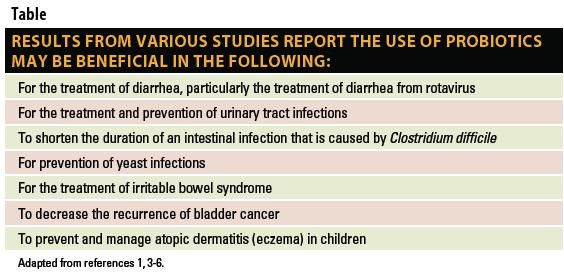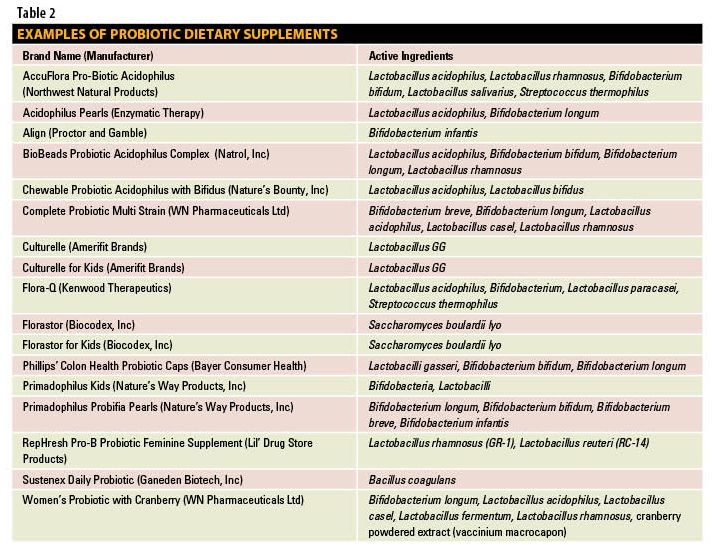Publication
Article
Pharmacy Times
Probiotic Supplements: Wonder Bugs
Author(s):
What are the benefits of probiotic products and do they really keep people healthy?
What are the benefits of probiotic products and do they really keep people healthy?
Over the past decade, probiotic supplements have gained popularity and are now used often to promote, improve, and maintain digestion. According to the World Health Organization and the Food and Agriculture Organization of the United Nations, probiotics are defined as “live microorganisms, which when given in adequate amounts, confer a health benefit on the host.”1-4
According to the Handbook of Nonprescription Drugs, probiotics are linked to several actions, which include competition with pathogens for the binding sites on intestinal mucosa, the reduction of intestinal permeability, changes of the intestinal pH, and direct antimicrobial effect against some pathogens.1
Probiotics are strains of nonpathogenic microorganisms normally present in the human gut or as components of foods, beverages, and supplements.1,4 They are often present in fermented products such as dairy products (ie, yogurt, yogurt drinks, buttermilk), some juices, soy beverages, and plants (sauerkraut and miso), and in dietary supplements available in a variety of dosage forms such as capsules, tablets, and powders. In both probiotic foods and dietary supplements, the bacteria may be present already or may be added during the preparation of the product.3
Protective Effects
Probiotics have been used to prevent or decrease recurring vaginal yeast infections, as well as to treat various medical conditions that may change the normal flora of the intestines (ie, antibiotic-associated diarrhea, traveler’s diarrhea, infectious diarrhea) as well as inflammatory and functional bowel conditions, and to support general wellness.1,2
Various studies have postulated that the use of probiotics is possibly associated with protective health effects.1 Examples of possible protective effects of probiotics include gastrointestinal barrier function, inhibition of the growth of potential pathogens, alteration of epithelial cell cytokine production, enhancement of antiviral activity, and regulation of T-cell induction.1 Ongoing research has demonstrated and provided encouraging evidence about the benefits of probiotics, such as decreasing the risk of certain diarrheal illnesses, assisting those with lactose intolerance to better digest the enzyme lactose, and enhancing immune function (Table 1).1,3-6

The use of probiotics has also been studied for its role in treating upper respiratory infections (eg, acute otitis media); reducing the risk of colon and bladder cancer, allergic diseases, and atopy; boosting immune response; and preventing dental caries.1,2 Clinical studies have examined the role of probiotics in treating various allergic conditions as well.5,6 Results suggest that certain probiotics may have an impact on the mucosal barrier function of the intestinal tract, which affects allergens entering the body and the activity of inflammation-producing cells.5
Some preliminary studies also report that certain probiotics may have a role in decreasing the development of allergies in the pediatric population, decreasing Helicobacter pylori colonization of the stomach, helping patients cope with side effects of antibiotic therapy, managing relapse of some inflammatory bowel conditions, decreasing dental-caries—causing microbes in the mouth, and keeping people healthy.6 For more information on the current clinical trials investigating the use of probiotics, please visit the National Institutes of Health’s Clinical Trials at www.clinical trials.gov/ct2/results?term=probiotics.
Probiotic Supplements
Probiotic supplements may contain the species Lactobacillus, Bifidobacterium, and Saccharomyces. Various preparations are available and contain 1 or more species. Within the Lactobacillus strain, Lactobacillus reuteri is the most prevalent strain found in the human body.1 Supplements currently on the market may contain Lactobacillus rhamnosus GG, reuteri, acidodphilus, bulgaricus, and fermentum.1,7 Strains of Bifidobacterium found in supplements include B longum, bifidum, breve, infanti, or lactis. Saccharomyces boulardii, which is yeast, is the only one of the Saccharomyces strain that is used in dietary supplements.1 Lactobacillus and Saccharomyces products are recommended for antibiotic-associated diarrhea and Lactobacillus rhamnosus GG is recommended for atopy and dermatitis.7
Prior to using any probiotic supplement, individuals—particularly those with concurrent medical conditions—should seek advice from their primary health care provider to ascertain the appropriateness. Also, women who are pregnant or breastfeeding should always consult their physicians. Although there is limited data, there are no reports of harmful results associated with the use of probiotics in late-term pregnancies or in women breast feeding.1 Patients should be advised that concurrent administration of probiotic supplements and antibiotics or antifungal agents is typically not recommended, and dosing intervals of these agents should be spaced apart by several hours.1,7
In general, probiotic supplements are well-tolerated; however, some patients may experience mild episodes of bloating and flatulence, which tend to decrease over time.1 Episodes of diarrhea have been reported in the pediatric population.1,7 Patients who have any concerns about adverse effects should be encouraged to seek advice from their primary health care provider. Those individuals with compromised immune systems should be advised not to use probiotics because of the potential for systemic infections.1,7
Patients should be reminded to only utilize products from reputable companies and to adhere to the manufacturer’s dosage guidelines and directions for use.

Ms. Terrie is a clinical pharmacy writer based in Haymarket, Virginia.
References
1. Rollins C. Functional and meal replacement foods. In: Berardi R, Newton G, McDermott JH, et al, eds. Handbook of Nonprescription Drugs. 16th ed. Washington, DC: American Pharmacists Association;2009:433-434
2. Williams Nancy. Probiotics. Medscape Web site. Available at: www.medscape.com/viewarticle/719654.
3. An introduction to probiotics, get the facts. National Center for Complementary and Alternative Medicine Web site. Available at: http://nccam.nih.gov/health/probiotics.
4. Najm W and Lie D. Dietary supplements commonly used for prevention. Prim Care.2008;35(4):749-767.
5. ABCs of Probiotics. Dannon Probiotics Web site. Available at: www.dannonprobioticscenter.com/basics/basics_allergies.asp.
6. Probiotic Basics. USProbiotics Web site. Available at: www.usprobiotics.org/basics.asp#allergy.
7. McQueen C. Nonbotanical Natural Medicines. In: Berardi R, Newton G, McDermott JH, et al, eds. Handbook of Nonprescription Drugs. 16th ed. Washington, DC: American Pharmacists Association;2009:992.







